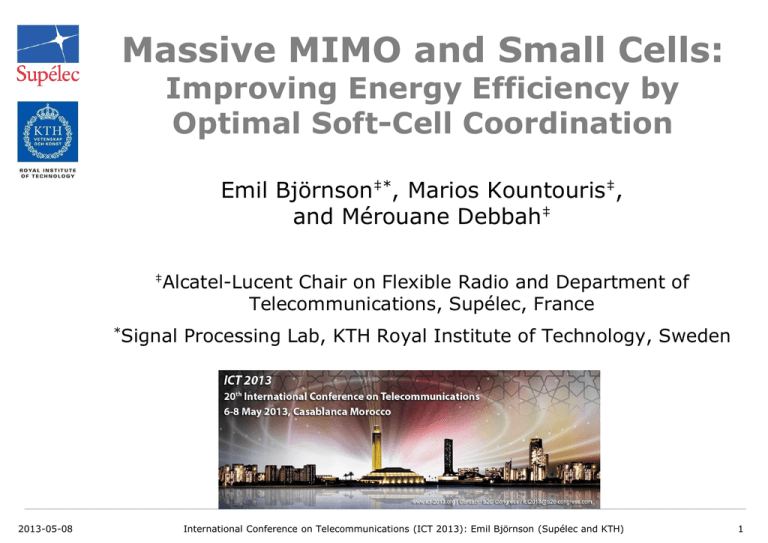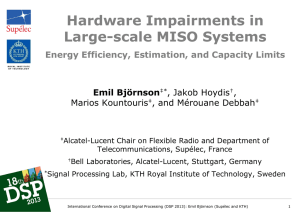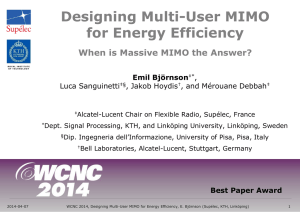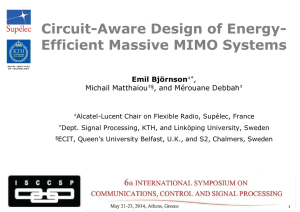Presentation - Communication Systems division
advertisement

Massive MIMO and Small Cells: Improving Energy Efficiency by Optimal Soft-Cell Coordination Emil Björnson‡*, Marios Kountouris‡, and Mérouane Debbah‡ ‡Alcatel-Lucent Chair on Flexible Radio and Department of Telecommunications, Supélec, France *Signal 2013-05-08 Processing Lab, KTH Royal Institute of Technology, Sweden International Conference on Telecommunications (ICT 2013): Emil Björnson (Supélec and KTH) 1 Introduction 2013-05-08 International Conference on Telecommunications (ICT 2013): Emil Björnson (Supélec and KTH) 2 Challenge of Network Traffic Growth • Data Dominant Era - 66% annual growth of traffic - How to achieve in a cost and energy efficient way? Source: Cisco Visual Networking Index 2013 2013-05-08 Source: Unstrung Pyramid Research 2010 International Conference on Telecommunications (ICT 2013): Emil Björnson (Supélec and KTH) 3 Is There a Need for Magic? • Still Room for Conventional Approaches - Allocate more spectrum - Network densification • More Frequency Spectrum - Scarcity in conventional bands: Offload to mmWave bands, Cognitive radio - Joint optimization of current networks (Wifi, 2G/3G/4G) • Network Densification Our Focus: 2013-05-08 - Increased spatial reuse of spectrum - More antennas/km2 (smaller cells, larger antenna arrays) International Conference on Telecommunications (ICT 2013): Emil Björnson (Supélec and KTH) 4 Two Approaches to Densification • Massive MIMO (multiple-input, multiple-output) - Large antenna arrays: High beamforming resolution - Deploy at macro base stations (BSs) - Energy efficiency: Array gain + little interference • Small Cells - Much traffic is localized and request by low-mobility users - Deploy low-power small-cell access points (SCAs) - Energy efficiency: Higher cell density Smaller path losses 2013-05-08 International Conference on Telecommunications (ICT 2013): Emil Björnson (Supélec and KTH) 5 Combination: Heterogeneous Network • Soft-Cell or Same-Cell Approach - Overlay existing macro BS with SCAs BS: Guarantees coverage SCAs: Higher efficiency Transparent to users • Coordination Issue - Control interference between BS/SCAs - User-deployed SCAs: Only time/frequency division? - Operator-deployed SCAs: Is spatial division possible? Main Question: What is achievable with perfect spatial coordination of BS and SCAs? 2013-05-08 International Conference on Telecommunications (ICT 2013): Emil Björnson (Supélec and KTH) 6 Problem Formulation 2013-05-08 International Conference on Telecommunications (ICT 2013): Emil Björnson (Supélec and KTH) 7 Can Massive MIMO + Small Cells Deliver? • Problem Formulation (vaguely) - Minimize total power consumption - Guarantee downlink quality-of-service at users (bits/s/Hz) - Satisfy power constraints (very strict at SCAs) • How to Model Total Power Consumption? - Dynamic part: Emitted power + Loss in amplifiers - Static part: Powering of circuits related to each antenna Predicted Impact of Massive MIMO and Small Cells: Great decrease of dynamic part Price: More hardware means higher static part Will pros outweigh cons? What is a good practical deployment? 2013-05-08 International Conference on Telecommunications (ICT 2013): Emil Björnson (Supélec and KTH) 8 System Model • Downlink Scenario - One Macro BS: 𝑁𝐵𝑆 antennas 𝑆 SCAs: 𝑁𝑆𝐶𝐴 antennas each 𝐾 single-antenna users h𝑘,𝑗 channel to user 𝑘 from BS (𝑗 = 0) or 𝑗th SCA • Received at user 𝑘: - Flat-fading subcarrier From BS User Assignment Automatic and optimal 2013-05-08 • Multiflow Linear Beamforming - All BS and SCAs can send independent signals to all users: - Joint non-coherent From SCAs Noise Beamforming Data signal International Conference on Telecommunications (ICT 2013): Emil Björnson (Supélec and KTH) 9 System Model (2) Inefficiency of amplifiers • Power Consumption - Dynamic part: - Static part: 𝐶 = Number Circuit power/antenna of subcarriers • 𝐿𝑗 Power Constraints per BS/SCA: Weighting matrix 2013-05-08 Positive limit International Conference on Telecommunications (ICT 2013): Emil Björnson (Supélec and KTH) Examples Per-antenna Constraints Per-BS/SCA constraints 10 Problem Formulation • Optimization Problem: Ultimate Bound Ideal channel knowledge and backhaul Quality of Service • Signal to Interf. and Noise Ratio: • What do we Seek? - Solve this problem optimally - Investigate which BS/SCAs will serve each user - Compare different number of antennas and SCAs 2013-05-08 International Conference on Telecommunications (ICT 2013): Emil Björnson (Supélec and KTH) 11 Analytic and Algorithmic Results 2013-05-08 International Conference on Telecommunications (ICT 2013): Emil Björnson (Supélec and KTH) 12 Optimal Solution • Semi-Definite Reformulation ( ): QoS Targets - Semi-definite program except for rank-constraint Theorem (Convex relaxation) • Suppose we drop the rank-constraints • Still always have a solution with 2013-05-08 Hidden convexity Optimal solution in polynomial time International Conference on Telecommunications (ICT 2013): Emil Björnson (Supélec and KTH) 13 Automatic Transmitter-User Assignment Corollary For each user in the optimal solution: 1. Served by only BS 2. Served by only 𝑗th SCA 3. Served by a combination of BS/SCAs (whereof one has active power constraints, i.e., insufficient power) • Conclusions: - Most users served exclusively by one transmitter Spatial multiflow beamforming often not needed Transitions regions around SCAs Dynamic/self-organizing based on user load No power constraints No transition regions M. Bengtsson, “Jointly optimal downlink beamforming and base station assignment,” in Proc. IEEE ICASSP, 2001. 2013-05-08 International Conference on Telecommunications (ICT 2013): Emil Björnson (Supélec and KTH) 14 Low-Complexity Algorithm • Optimal Solution in Polynomial Time - Complexity scales ≥cubic in number of antennas and users - Modest complexity but infeasible for large arrays Algorithm: Multiflow-RZF beamforming 1. All transmitters use regularized zero-forcing (RZF) as beamforming directions 2. SCAs send scalars of effective channel gains to BS 3. BS solves reduced-complexity linear problem: 4. BS informs SCAs on power allocation to users 2013-05-08 International Conference on Telecommunications (ICT 2013): Emil Björnson (Supélec and KTH) 15 Simulation Examples 2013-05-08 International Conference on Telecommunications (ICT 2013): Emil Björnson (Supélec and KTH) 16 Simulation Scenario Channel Parameters Rayleigh fading (uncorrelated for SCAs and correlated for BS) 3GPP models for shadow fading and path/penetration loss 600 subcarriers 2013-05-08 International Conference on Telecommunications (ICT 2013): Emil Björnson (Supélec and KTH) 17 Can Massive MIMO + Small Cells Deliver? • Power Consumption with 2 bits/s/Hz per user: • Conclusions 2013-05-08 Both densification techniques work by themselves Combination makes even more sense Saturation can be observed (very parameter dependent) 0-5% probability of multiflow beamforming International Conference on Telecommunications (ICT 2013): Emil Björnson (Supélec and KTH) 18 Low-Complexity Coordination • What is Achievable in Practice? - For different QoS constraints (𝑁𝐵𝑆 = 50, 𝑁𝑆𝐶𝐴 = 2) Practical performance • Conclusions - Proposed algorithm obtains large gain by using small cells - Substantial gap is positive for practical applications 2013-05-08 International Conference on Telecommunications (ICT 2013): Emil Björnson (Supélec and KTH) 19 Summary 2013-05-08 International Conference on Telecommunications (ICT 2013): Emil Björnson (Supélec and KTH) 20 Summary • Improve Energy-Efficiency by Network Densification - Massive MIMO – Large arrays at macro BSs - Small Cells – New power-limited SCAs - Does it make sense to combine them? • Spatial Soft-Cell Coordination - Optimal multiflow beamforming: Convex problem - Dynamic assignment of users to transmitters - Exclusive assignment is usually optimal • Proof-of-Concept by Simulation - Large energy savings due to decreased transmit power - Usually compensates for increased static hardware power - Low-complexity algorithms can bring great improvements 2013-05-08 International Conference on Telecommunications (ICT 2013): Emil Björnson (Supélec and KTH) 21 Thank You for Listening! Questions? All Papers Available: http://flexible-radio.com/emil-bjornson 2013-05-08 International Conference on Telecommunications (ICT 2013): Emil Björnson (Supélec and KTH) 22


